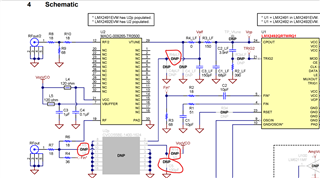Other Parts Discussed in Thread: LMX2492
Tool/software:
Hello,
We have recently purchased the LMX2492EVM and would like to clarify a few details regarding VCO replacement.
Our goal is to replace the onboard VCO on two separate occasions - one time with a VCO for the 5.8 GHz band and another time with a VCO for the 2.4 GHz band. Since the board has only one VCO slot, we plan to swap between these two VCOs for testing purposes.
We would appreciate guidance on the key parameters we need to verify before purchasing, such as physical size, tuning voltage range, and overall compatibility with the LMX2492EVM.
The two VCOs we are considering are:
CVCO55CC-2328-2536 (2.4 GHz)
CVCO55CXT-5700-5900 (5.8 GHz)
Additionally, we understand that replacing the VCO will require modifying certain resistors and capacitors on the board. Could you provide guidance or reference materials on how to properly calculate the required resistance and capacitance values to ensure optimal VCO operation for each of these two cases?
We appreciate your support and look forward to your advice.


